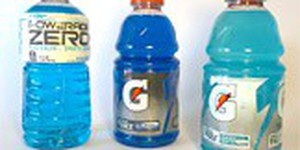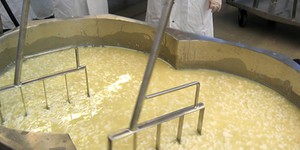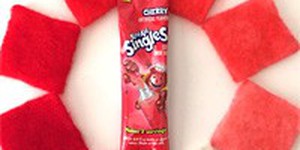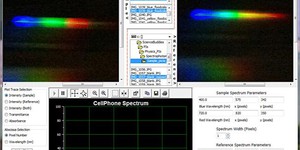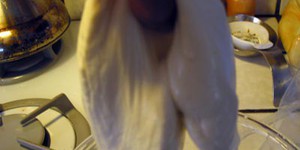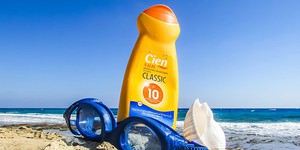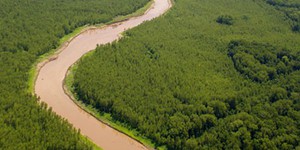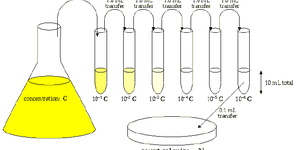Others Like “No Whey! Milk Protein Content Doesn't Change...Or Does It?” (top 20 results)
|
Do you read the list of ingredients in foods and drinks before you buy them at the grocery store? If you do, you may have noticed that many of the items, especially colored drinks, contain dyes with names such as FD&C Blue 1, Red 40, or Yellow 5. But how much dye is needed to create all these colors? In this chemistry science project, you will build a simple spectrophotometer that is able to measure the concentration of colored chemicals in solutions. You will test your device by measuring…
Read more
Have you ever gone to pour yourself a cup of milk and all you get is milk clumps? What happened to the milk is called coagulation, which is the mechanism that occurs when proteins in the milk clump together. While you do not necessarily want this in your milk, without coagulation (or curdling), there would not be any cheese or yogurt, which is why it is a very important process in the food industry. But what makes milk curdle? In this science project you will use pineapple juice to curdle milk…
Read more
Have you ever wondered how your clothes get their color? Dyeing textiles is a very complicated process and involves a lot of chemistry. Not only are the properties of the dye and fabric important, but the dyeing conditions also have to be exactly right to get optimal color adsorption. Curious about how it works? In this science project, you will color wool with Kool-Aid® and explore the chemistry of dyeing.
Read more
We encounter an amazing array of colors every day, from the greens of plants and the many colors of their flowers, to the pinkish blue of a sunset, to the artificial coloring in beverages. How do we perceive all of these colors? When light hits an object, some of that light is absorbed by the object, and the light that is not absorbed is what we see. In this science project, you will build a simple spectrophotometer from a cell phone and use it to investigate how visible light is absorbed by…
Read more
Oooey gooey cheese...yum! Who doesn't like a slice of warm pizza straight from the oven? There's nothing quite like a slice of pizza and a glass of milk, so what makes pizza so great? The cheese! But did you know that making cheese is all about science and chemistry? In this science fair project, you will learn more about the science of cheese making and what kind of milk works best. Try this science fair project and you'll learn about science and get something yummy to eat afterward!
Read more
Imagine a wonderful summer day at the beach. You play in the sand, swim in the ocean—and, of course, put a lot of sunscreen on. The sunscreen protects your skin from harmful ultraviolet (UV) radiation. Special ingredients absorb or reflect the UV rays so they do not harm your skin. Different types of sunscreen have different types of ingredients, and some of them can be harmful to the environment—especially if they get into the ocean. In this science project you will put your…
Read more
Your drinking water probably started out brown and muddy. Are you surprised? Maybe you were picturing it flowing from a clean mountain spring instead? All over the world, including in 68% of American homes, people get their drinking water from rivers, lakes, and other surface waters. This water is filled with dirt, debris, and other contaminants as it travels hundreds of miles. So, how does your drinking water go from brown and muddy to crystal clear? Often, flocculants—substances that…
Read more
A delicious and quick lunch is a cup of tomato soup and a grilled cheese sandwich. Biting into the toasty, butter-soaked bread and gooey cheese is very comforting. But what makes the cheese melt so nicely? Do all cheeses melt this way? In this cooking and food science fair project, you will experiment with making and determining the best recipe for processed cheese.
Read more
How does your family thaw and cook meat? Have you ever wondered if it is the safest way? In this practical science project, you can find out and shed light on safe practices in the kitchen by investigating how many viable bacteria are present in samples of meat that have been thawed or cooked using different methods.
Read more
Has a milk-based soup, sauce, or gravy ever curdled on you (formed lumps) as you were preparing it? Curdling is the process of coagulation that occurs where the proteins in the milk clump together. Sometimes curdling is desirable—for example, if you want to make a delicious cheese or yogurt—but if you are trying to make a milk-based soup or gratin, or if you're adding milk to a hot drink, curdling is very unwanted because you lose the smooth, creamy texture. Nobody likes clumps and…
Read more
|
Explore Our Science Videos
Flower Dissection – STEM Activity
Extract Iron from Cereal– Science Project
How To Curl Metals With Heat


